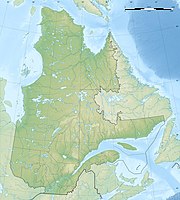Ecological Reserve Tapani
|
Ecological Reserve Tapani
|
||
| location | Antoine-Labelle , Québec, Canada | |
| surface | 0.17 km² | |
| WDPA ID | 18158 | |
| Geographical location | 46 ° 55 ′ N , 75 ° 20 ′ W | |
|
|
||
| Setup date | 1988 | |
| administration | MDDEP | |
The Réserve écologique Tapani is a 17 hectare protected area in the west of the Canadian province of Québec , which includes the Île Tapani (also Île du Héron Bleu , "Island of the Great Blue Heron "), an island in Lac Tapani about 3 km north of Sainte-Anne-du -Lac holds.
This place in turn belongs to the county municipality of Antoine-Labelle (administrative region Laurentides ) in the Laurentine Mountains . The focus of the conservation efforts is a 180 to 200 year old population of black ash trees , which form a biotope that is rare in the region. Here, unlike in most other cases of Réserves écologiques (loosely translated as 'ecological protected area'), it is not about the representation of the regional typical, but rather that of the exception. In addition, there are no signs of human interference.
The park area is located in a hilly region between 300 and 500 m above sea level, the island itself is 250 m above sea level. The rocky subsoil consists mainly of paragneiss and amphibolite overlaid by glacial tillite . The soil is composed of nutrient-poor podsol and gley , types of soil typical of the boreal forests of the region. The black ash tree , which is around 200 years old, which is strictly protected on the island, thrives on Gley , but also the yellow birch (Betula alleghaniensis) that grows on even more humid ground . In the west of the island there is a black ash grove on a sandy subsoil, which allows better water drainage.
In the park area there is also the Allium tricoccum (Ail des bois, 'forest garlic'), which is severely endangered in Québec .
The fauna is rather poor in species. The white-tailed deer is attracted by the soft leaves of the arborvitae, but snowshoe hares and squirrels (French: ècureuils) also live on the island in the “lake of thirty-one thousand”. Possibly the local name for the Tapani island goes back to the Algonquin word for a species of cress whose roots are edible. However, it is unclear whether it is the real watercress . It was successfully used against scurvy by the Indians living in the north . The name may also go back to the toboggan , a skidless sled that was also known as an otoban .
